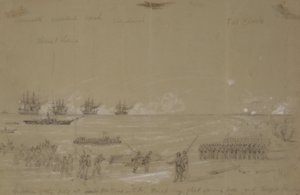Our website is made possible by displaying online advertisements to our visitors.
Please consider supporting us by disabling your ad blocker.
Battle of Hatteras Inlet Batteries
| Battle of Hatteras Inlet Batteries | |||||||
|---|---|---|---|---|---|---|---|
| Part of the American Civil War | |||||||
 Capture of the Forts at Cape Hatteras inlet Alfred Waud, artist, August 28, 1861 | |||||||
| |||||||
| Belligerents | |||||||
|
|
| ||||||
| Commanders and leaders | |||||||
|
Silas H. Stringham Benjamin F. Butler |
Samuel Barron William F. Martin | ||||||
| Units involved | |||||||
|
9th New York Infantry 20th New York Infantry Atlantic Blockading Squadron |
17th North Carolina Infantry Regiment Hatteras Island Garrison Unspecified naval volunteers | ||||||
| Strength | |||||||
|
7 warships 935 men[1] | 900 men | ||||||
| Casualties and losses | |||||||
|
1 killed 2 wounded |
4 killed 20 wounded 691 captured | ||||||
The Battle of Hatteras Inlet Batteries (August 28–29, 1861) was the first combined operation of the Union Army and Navy in the American Civil War, resulting in Union domination of the strategically important North Carolina Sounds.
Two forts on the Outer Banks, Fort Clark and Fort Hatteras, had been built by the Confederates to protect their commerce-raiding activity. These were lightly defended, however, and their artillery could not engage the bombarding fleet under Flag Officer Silas H. Stringham, commandant of the Atlantic Blockading Squadron, which had been ordered to keep moving, to avoid presenting a static target. Although held up by bad weather, the fleet was able to land troops under General Benjamin Butler, who took the surrender of Flag Officer Samuel Barron.
This battle represented the first application of the naval blockading strategy. The Union retained both forts, providing valuable access to the sounds, and commerce raiding was much reduced. The victory was welcomed by a demoralized Northern public after the humiliating First Battle of Bull Run. The engagement is sometimes known as the Battle of Forts Hatteras and Clark.
Previous Page Next Page


